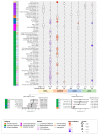Polygenic Risk Scores Associated with Tumor Immune Infiltration in Common Cancers
- PMID: 36428664
- PMCID: PMC9688863
- DOI: 10.3390/cancers14225571
Polygenic Risk Scores Associated with Tumor Immune Infiltration in Common Cancers
Abstract
It is largely unknown whether genetic susceptibility contributes to tumor immune infiltration in common cancers. We systematically investigated the association between polygenic risk scores (PRSs) and tumor immune infiltration in common cancers. First, we constructed a PRS for common cancers using the risk variants identified in previous genome-wide association studies. Then, we analyzed 139 immune traits predicted by previous studies by examining gene expression data in tumor tissues from The Cancer Genome Atlas (TCGA). We applied regression analyses to evaluate the associations between PRS and immune traits for each cancer overall and stratified by stage, including 2160 pathologically confirmed cases of breast, colorectal, lung, ovarian, pancreatic, and prostate cancers in the White population. At a nominal (p < 0.05) significance level, we identified 31 significant associations between PRS and immune traits. In the analyses stratified by stage for breast, colorectal, lung adenocarcinoma, and lung squamous cell carcinoma, we identified 65 significant associations, including 56 associations that were undetected by the overall analysis. This study provides evidence for genetic risk factors affecting immune infiltration and provides novel insights into the role of genetic susceptibility in immune responses, underlying cancer development, prognosis, and the potential role of an early diagnostic or therapeutic targeting strategy.
Keywords: cancer genetic susceptibility; genome-wide association study; polygenic risk score; tumor immune infiltration.
Conflict of interest statement
The authors declare no conflict of interest.
Figures



References
-
- Phelan C.M., Kuchenbaecker K.B., Tyrer J.P., Kar S.P., Lawrenson K., Winham S.J., Dennis J., Pirie A., Riggan M.J., Chornokur G., et al. Identification of 12 New Susceptibility Loci for Different Histotypes of Epithelial Ovarian Cancer. Nat. Genet. 2017;49:680–691. doi: 10.1038/ng.3826. - DOI - PMC - PubMed
-
- McKay J.D., Hung R.J., Han Y., Zong X., Carreras-Torres R., Christiani D.C., Caporaso N.E., Johansson M., Xiao X., Li Y., et al. Large-Scale Association Analysis Identifies New Lung Cancer Susceptibility Loci and Heterogeneity in Genetic Susceptibility across Histological Subtypes. Nat. Genet. 2017;49:1126–1132. doi: 10.1038/ng.3892. - DOI - PMC - PubMed
-
- Wang Z., McGlynn K.A., Rajpert-De Meyts E., Bishop D.T., Chung C.C., Dalgaard M.D., Greene M.H., Gupta R., Grotmol T., Haugen T.B., et al. Meta-Analysis of Five Genome-Wide Association Studies Identifies Multiple New Loci Associated with Testicular Germ Cell Tumor. Nat. Genet. 2017;49:1141–1147. doi: 10.1038/ng.3879. - DOI - PMC - PubMed
-
- Klein A.P., Wolpin B.M., Risch H.A., Stolzenberg-Solomon R.Z., Mocci E., Zhang M., Canzian F., Childs E.J., Hoskins J.W., Jermusyk A., et al. Genome-Wide Meta-Analysis Identifies Five New Susceptibility Loci for Pancreatic Cancer. Nat. Commun. 2018;9:556. doi: 10.1038/s41467-018-02942-5. - DOI - PMC - PubMed
Grants and funding
LinkOut - more resources
Full Text Sources

